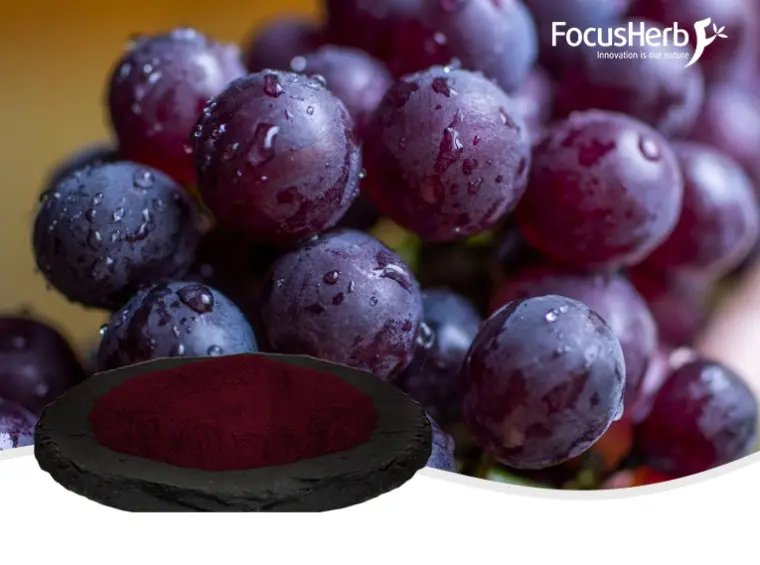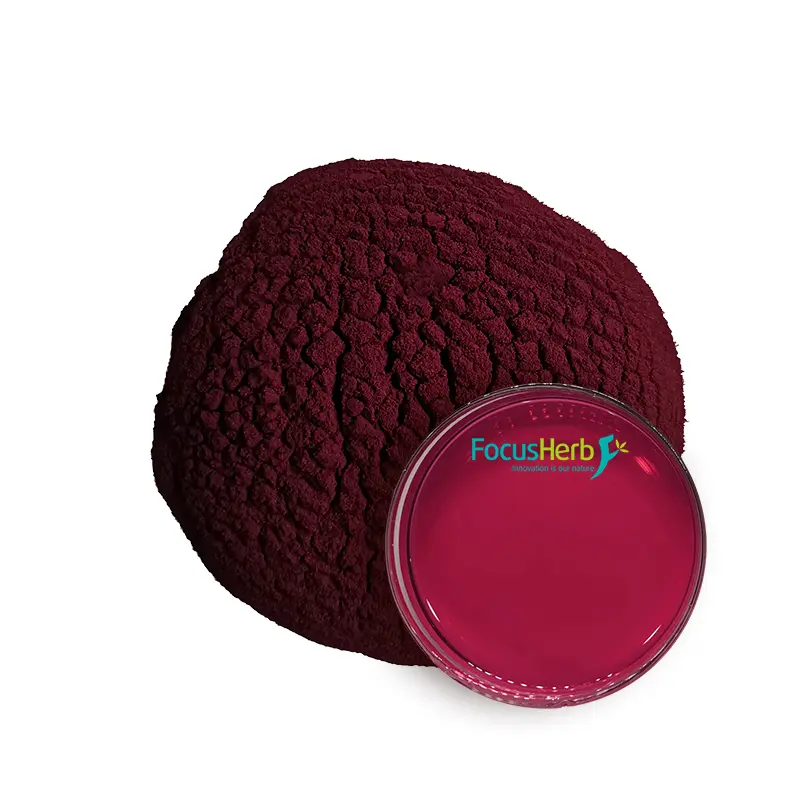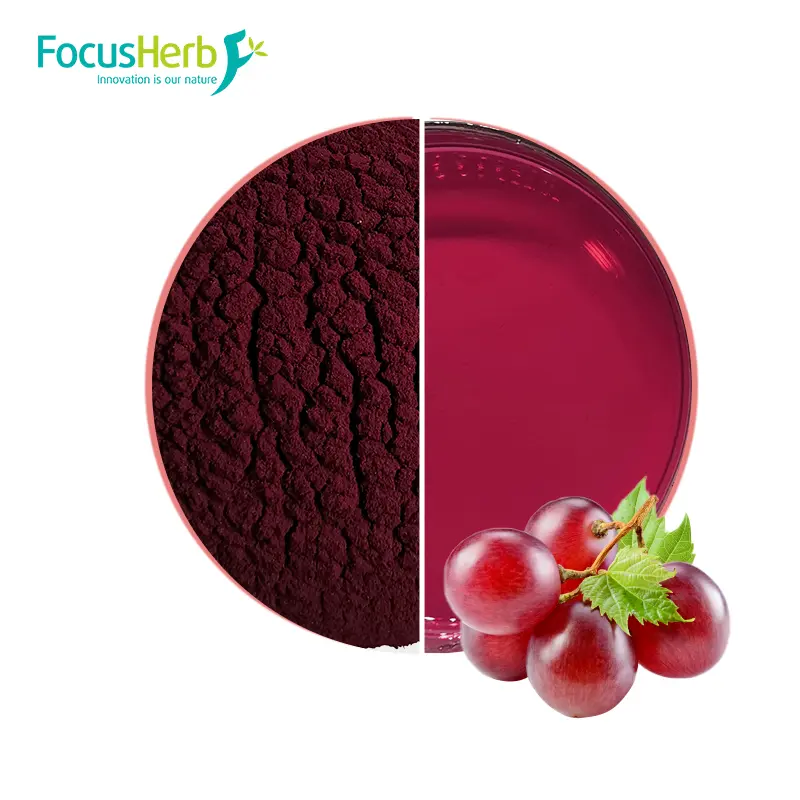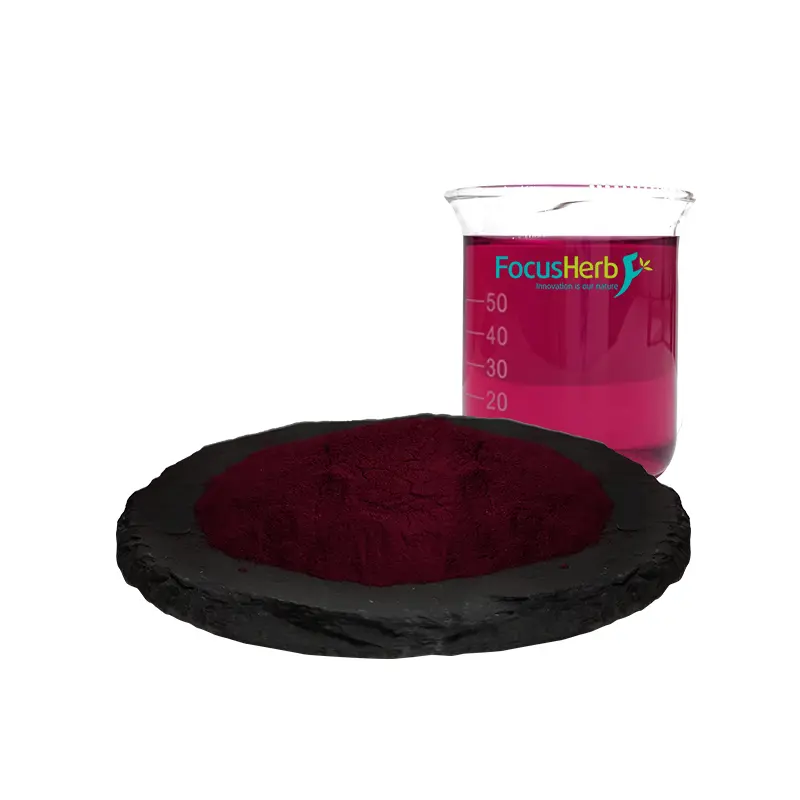In our daily lives, we’re often drawn to vibrantly colored foods. Grape skin red, as a natural pigment, quietly plays a crucial role in these vibrant colors. Whether you savor an alluring purple-red juice drink, take a bite of vibrant grape-flavored candy, or enjoy a piece of cake adorned with beautiful purple cream, it’s likely grape skin red that imbues them with its captivating hue. Like a magical painter, it uses unique brushstrokes to depict the vibrant world of food, enhancing our dining experience. Beyond the food sector, grape skin red is also increasingly emerging in the cosmetics, pharmaceutical, and other industries, playing a unique role. So, what exactly is this highly sought-after grape skin red? What are its unique characteristics? Let’s delve deeper into the secrets of grape skin red.
The Origin of Grape Skin Red
Grape skin red, as a natural pigment, has a history closely tied to grapes. Grapes, this ancient and widely cultivated fruit, have played a crucial role throughout human history. From their earliest use as food to their later use in winemaking, the uses of grapes have continuously expanded. Grape skin red is extracted from the skins of grapes of the genus Vitis in the Vitaceae family. Extraction typically uses dark red or purple grape skins, primarily the pomace after juicing. This allows grape skin red to be extracted, to a certain extent, a secondary resource.
The extraction process for grape skin red has undergone a long and complex development. Early techniques for extracting the pigment from grape skins were relatively simple and crude. Records of extracting grape skin red from red grape pomace exist as early as the 19th century. In 1879, Italy became the first country to commercialize a pigment extracted from grape skins, marking a significant milestone in the application of grape skin red extraction technology. However, extraction methods at the time likely involved simple, preliminary treatments such as soaking and filtration, resulting in products of relatively poor purity and stability.
With the continuous advancement of science and technology, extraction processes are also undergoing continuous refinement. Modern extraction techniques increasingly focus on improving the extraction efficiency, purity, and stability of the pigment. For example, the current common extraction process involves removing seeds and other impurities from the grape pomace, followed by purification processes such as extraction, filtration, and concentration. Selecting the right solvent is crucial during the extraction process, with water and ethanol being common solvents. To improve product stability, maltodextrin or modified starch is added, and the product is finally spray-dried into a powder for easier storage and transportation. Furthermore, green and environmentally friendly extraction techniques such as enzymatic hydrolysis and supercritical fluid processing are increasingly being applied to grape skin red extraction. These new technologies not only improve extraction efficiency but also reduce environmental impact, driving the grape skin red industry towards a greener and more efficient direction.
The Amazing Properties of Grape Skin Red
Grape skin red has a unique appearance and odor. It ranges from red to dark purple and can be in liquid, solid, paste, or powder form, with a distinctive odor. Regarding solubility, it is well soluble in common solvents such as water, ethanol, and propylene glycol, but insoluble in oils and fats. This solubility makes it particularly suitable for use in water-based systems or those containing ethanol or propylene glycol.
Its color also changes dramatically with changes in the pH of the solution. Under acidic conditions, it exhibits a vibrant red to purple-red color, reminiscent of ripe red grapes. This is why grape skin red can create an attractive purple-red hue in acidic juice drinks, jams, and other products, adding to their appeal. However, under alkaline conditions, it miraculously transforms to a dark blue. This pH-dependent color change not only has unique applications in food coloring but also serves as a reference for acid-base indicators in some chemical experiments and testing. For example, this characteristic of grape skin red can serve as a key indicator when studying the effect of pH on the color stability of certain foods.
In the presence of iron ions, the color of grape skin red deepens further, becoming a dark purple. This characteristic requires special attention in practical applications. During the production process of products using grape skin red as a pigment, if it comes into contact with iron-containing containers or raw materials, it can cause color changes, affecting the product’s color quality. For example, if iron pots are used to cook homemade grape skin red-dyed foods, the final color may be darker than expected. Grape Skin Red performs averagely in terms of heat resistance and dyeing properties. At higher temperatures, its color stability is affected, potentially leading to fading or discoloration. This limits its use in some high-temperature processed foods, such as baked goods. If the baking temperature is too high, Grape Skin Red’s color will struggle to maintain its vibrant color. While its dyeing properties meet the coloring needs of some common products, it may lag behind some synthetic pigments in terms of color fastness and uniformity. However, it’s worth noting that vitamin C improves its light resistance, and polyphosphate stabilizes its color. In practical applications, the addition of these substances can improve the performance of Grape Skin Red, allowing it to better perform its coloring function in products.
Applications of Grape Skin Red
The Magic of Color in the Food Industry
In the food industry, grape skin red, with its unique color and natural properties, has become a “color magician” for numerous foods. In the beverage world, whether it’s refreshing carbonated drinks or nutritious juice (flavored) beverages, grape skin red shines brightly. For example, a well-known brand of grape-flavored carbonated beverage, after adding grape skin red, takes on an alluring purple-red hue, resembling a bunch of ripe grapes bottled in a bottle, greatly stimulating consumer demand. In juice drinks, it not only adds color but also complements the flavor of the juice itself, giving consumers a rich, fruity aroma both visually and palate-wise.
Grape skin red is also indispensable in baked goods. When used in baking, the appropriate amount of grape skin red can enhance the vibrant and eye-catching appearance of pastries. For example, in some European-style pastries, the purple-red frosting or filling made with grape skin red adds a touch of elegance and refinement, making the pastries stand out from the crowd. For candies, grape skin red offers a rich variety of color options, ranging from light pink-purple to deep purple-red, satisfying the color preferences of various consumers. For example, the addition of grape skin red to fruit candies and soft candies not only enhances their color but also imparts a subtle grape aroma, enhancing both taste and visual appeal.
In jam making, grape skin red can adjust the color of the jam, bringing it closer to the color of fresh fruit and enhancing the product’s quality. In frozen drinks, such as ice cream, it can impart a dreamy purple hue, providing a refreshing and unique visual experience on a hot summer day. Grape skin red plays a crucial role in winemaking, contributing not only to the wine’s color but also to its flavor and quality, imparting a rich taste and captivating purple-red hue.
The unique charm of other industries
Beyond its success in the food industry, grape skin red has also demonstrated its unique appeal in other sectors. In the cosmetics industry, grape skin red is widely used in makeup products such as lipstick, eye shadow, and blush, as well as in skincare products. In lipstick, grape skin red imparts a natural, vibrant red hue. Due to its natural properties, it is gentler on lips than some synthetic pigments, reducing the risk of allergic reactions. In eye shadow and blush, grape skin red creates a unique purple-red hue, adding a stylish and personal touch. In skincare, grape skin red’s antioxidant properties are fully utilized, helping the skin protect against free radical damage and delaying aging. It also adds a subtle hue to skincare products, enhancing their appeal.
Grape skin red also has applications in the pharmaceutical industry. Some pharmaceuticals use grape skin red to color the sugar coating or capsule shell, making them more acceptable to patients. Due to its antioxidant and anti-inflammatory properties, grape skin red is also used in the development of functional drugs and health supplements. For example, in certain health supplements for cardiovascular disease prevention, grape skin red, as a natural antioxidant, works synergistically with other nutrients to help the body scavenge free radicals and reduce the risk of cardiovascular disease.
In the industrial sector, grape skin red can be used as a dye or pigment, imparting a red or purple hue to products such as coatings, paints, plastics, rubber, and paper. Adding grape skin red to coatings and paints creates unique color effects when used to decorate surfaces, enhancing the aesthetics of buildings and furniture. In plastic and rubber products, grape skin red can impart vibrant colors, enhancing their appeal and satisfying consumers’ demand for personalized and aesthetically pleasing products. In paper dyeing, grape skin red can impart unique colors, enabling the production of colored and art paper, bringing new color options to the paper products industry.
In the chemical industry, grape skin red can be used as a raw material or auxiliary agent in certain chemical reactions, such as as an antioxidant or stabilizer. In some oxidation-sensitive chemical reaction systems, grape skin red’s antioxidant properties can protect the reaction system from oxidative damage, ensuring smooth reaction progress. In the textile industry, grape skin red can be used as a natural dye for dyeing or printing natural fibers such as cotton, linen, and silk. Textiles dyed with grape skin red offer vibrant colors and possess certain natural health benefits, meeting consumers’ current demand for environmentally friendly and healthy textiles.
Safety Analysis of Grape Skin Red
With food safety a major concern, the safety of food additives has become a hot topic of public debate. Grape Skin Red, as a food additive, is also a subject of considerable concern. Researchers have conducted rigorous research, with mouse data providing robust evidence. The median lethal dose (LD50) of grape skin red in mice exceeded 15 g/kg body weight when administered orally, consistent with results in both male and female mice. This suggests that grape skin red may only be lethal at extremely high doses, while its safety is relatively high within the normal range of food addition.
The standards jointly developed by the Codex Alimentarius Commission (CAC) and the World Health Organization (WHO) stipulate that the acceptable daily intake (ADI) for grape skin red ranges from 0 to 52.5 mg/kg body weight. This standard, derived from extensive scientific research and risk assessment, provides a scientifically sound safety limit for the use of grape skin red in food. In China, the “National Food Safety Standard – Food Additive Usage Standard” (GB 2760-2014) also clearly stipulates the maximum usage of grape skin red in different food categories, ensuring consumer safety from a regulatory perspective.
From a source and ingredient perspective, grape skin red, as a natural pigment extracted from grape skins, is more natural than some synthetic pigments and carries a lower risk of harmful residues. Furthermore, technological advancements in the extraction and production processes have led to more thorough removal of impurities and harmful substances, further enhancing its safety. Therefore, as long as the usage scope and dosage specified in the national standard are met, consumers can safely consume foods containing grape skin red without undue concern about its safety.
Future Outlook for Grape Skin Red
With the rapid advancement of technology and consumers’ growing demand for healthy and environmentally friendly products, the future of grape skin red is filled with boundless possibilities and potential. Within the food industry, grape skin red is expected to play a key role in more innovative food products. For example, in the emerging plant-based food sector, whether it’s plant-based meat, plant-based milk, or artificial seafood, suitable pigments are needed to simulate the color of real meat or dairy products. Grape skin red, with its natural properties, can give these plant-based products an attractive appearance, satisfying consumers’ demand for both appearance and quality, and driving further development of the plant-based food market.
In the area of personalized food, with the increasing application of 3D printing technology in the food industry, more and more foods will be customized to consumers’ individual tastes and nutritional needs. Grape skin red can be used as a personalized color additive to meet the unique color requirements of different consumers, providing consumers with a unique dining experience. For example, consumers can select their preferred food color and shape through online platforms and use 3D printing technology to create customized candies, cakes, and other foods containing grape skin red.
In the cosmetics industry, grape skin red will also see further development. As people’s interest in skin health and natural ingredients continues to grow, natural pigments with antioxidant and anti-inflammatory properties will be increasingly used in cosmetics. Grape skin red not only serves as a natural pigment to enhance cosmetics, but its diverse active ingredients also provide enhanced skincare benefits. In the future, more high-end skincare products featuring grape skin red as a core ingredient are expected to emerge, such as creams and serums with deep antioxidant and skin barrier repair properties, fulfilling consumers’ dual pursuits of skin health and beauty.
Amidst growing environmental awareness, the concept of sustainable development will have a profound impact on the future development of grape skin red. In grape cultivation, organic and ecological farming techniques will be more widely adopted, reducing the use of chemical pesticides and fertilizers, ensuring the green and pollution-free nature of grape raw materials, and guaranteeing the quality and safety of grape skin red from the source.
In terms of extraction processes, green and environmentally friendly extraction technologies will become mainstream. Technologies such as enzymatic hydrolysis and supercritical fluid processing not only improve the extraction efficiency and purity of grape skin red, but also reduce energy consumption and waste emissions, achieving efficient resource utilization and environmental protection. By optimizing the extraction process, the production cost of grape skin red can be further reduced, enhancing its market competitiveness. From an industrial chain perspective, a more comprehensive grape skin red industry ecosystem is likely to emerge in the future. Collaboration between upstream grape growers, midstream extraction and processing companies, and downstream application companies will strengthen, enabling information sharing and resource complementarity, jointly driving the development of the grape skin red industry. Companies may also strengthen the comprehensive development and utilization of grape skin red byproducts, such as extracting resveratrol, proanthocyanidins, and other high-value-added ingredients from the residue left after grape skin red extraction. This will maximize resource utilization and enhance both economic and social benefits.
Although grape skin red faces challenges in its future development, such as fluctuating raw material prices and intensified market competition, by seizing opportunities, proactively addressing challenges, and continuously innovating and improving, grape skin red is poised to shine even brighter in numerous fields, bringing greater beauty and value to people’s lives.






















